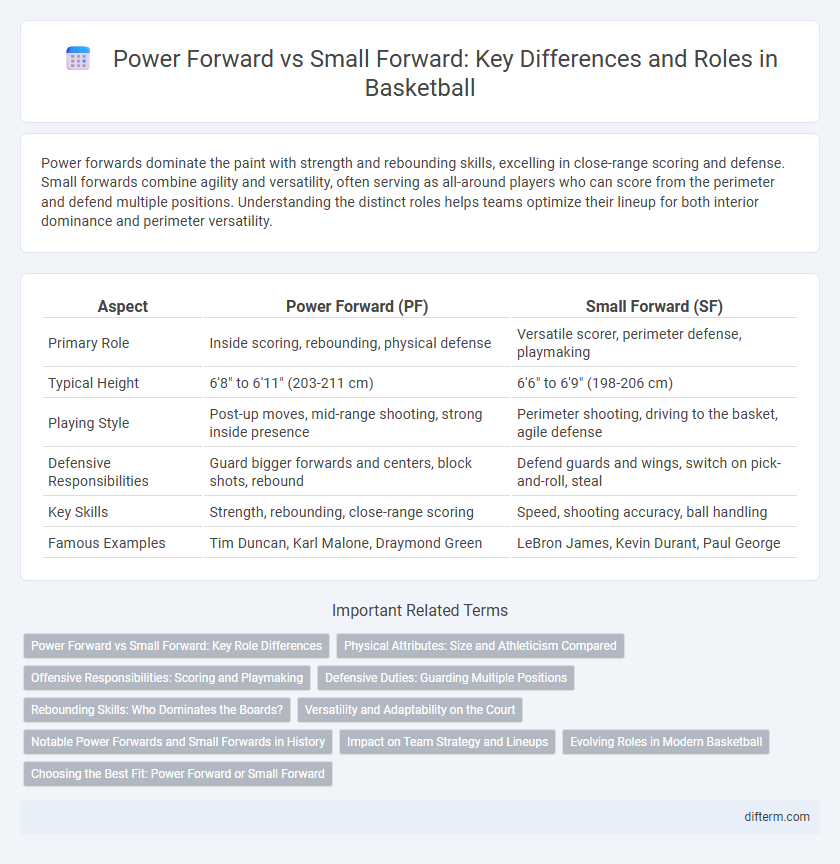Power forwards dominate the paint with strength and rebounding skills, excelling in close-range scoring and defense. Small forwards combine agility and versatility, often serving as all-around players who can score from the perimeter and defend multiple positions. Understanding the distinct roles helps teams optimize their lineup for both interior dominance and perimeter versatility.
Table of Comparison
| Aspect | Power Forward (PF) | Small Forward (SF) |
|---|---|---|
| Primary Role | Inside scoring, rebounding, physical defense | Versatile scorer, perimeter defense, playmaking |
| Typical Height | 6'8" to 6'11" (203-211 cm) | 6'6" to 6'9" (198-206 cm) |
| Playing Style | Post-up moves, mid-range shooting, strong inside presence | Perimeter shooting, driving to the basket, agile defense |
| Defensive Responsibilities | Guard bigger forwards and centers, block shots, rebound | Defend guards and wings, switch on pick-and-roll, steal |
| Key Skills | Strength, rebounding, close-range scoring | Speed, shooting accuracy, ball handling |
| Famous Examples | Tim Duncan, Karl Malone, Draymond Green | LeBron James, Kevin Durant, Paul George |
Power Forward vs Small Forward: Key Role Differences
Power forwards primarily focus on physicality, rebounding, and inside scoring, often playing close to the basket to secure points in the paint and defensive boards. Small forwards emphasize versatility, ball handling, and perimeter shooting, frequently acting as secondary playmakers and defenders against wing players. The key role difference lies in power forwards dominating the post area while small forwards balance scoring, defense, and facilitating roles across the court.
Physical Attributes: Size and Athleticism Compared
Power forwards typically possess greater height and muscular build, averaging around 6'8" to 6'11" and 240 to 260 pounds, enabling them to dominate in the paint and battle for rebounds. Small forwards usually stand between 6'6" and 6'9" with leaner frames ranging from 200 to 230 pounds, emphasizing agility and quickness to excel in perimeter defense and slashing drives. Athleticism varies as well, with power forwards relying on strength and verticality, while small forwards leverage speed and lateral movement for versatile scoring and defensive roles.
Offensive Responsibilities: Scoring and Playmaking
Power forwards primarily focus on scoring through post moves and rebounding, often operating close to the basket to exploit their size and strength. Small forwards excel at versatile scoring by driving to the basket, shooting from mid-range, and creating plays, utilizing agility and perimeter shooting skills. Both positions contribute to playmaking, but small forwards typically have greater ball-handling responsibilities, facilitating offensive sets and creating scoring opportunities for teammates.
Defensive Duties: Guarding Multiple Positions
Power forwards excel in defending against post players and battling for rebounds, showcasing strength and interior presence. Small forwards demonstrate versatility by guarding perimeter players and switching onto guards, leveraging agility and lateral quickness. Both positions require adaptability to effectively guard multiple positions and disrupt offensive schemes in modern basketball.
Rebounding Skills: Who Dominates the Boards?
Power forwards dominate rebounding with their size and strength, averaging 8-12 rebounds per game, often controlling the defensive glass and securing second-chance opportunities. Small forwards contribute with agility and positioning, averaging 5-7 rebounds, but rarely match the sheer physicality power forwards bring to the boards. Rebounding efficiency metrics consistently highlight power forwards as the primary rebounders, crucial for team possession and transition plays.
Versatility and Adaptability on the Court
Power forwards demonstrate strength and rebounding skills, excelling in post plays and defending larger opponents, while small forwards offer greater agility and perimeter shooting capabilities, making them crucial for versatile offensive strategies. Small forwards adapt quickly to multiple positions, often serving as secondary ball handlers and key defenders against wing players. Power forwards, however, combine physicality with increasingly refined ball-handling and shooting, enhancing their adaptability in modern, fast-paced basketball systems.
Notable Power Forwards and Small Forwards in History
Karl Malone and Tim Duncan stand out as some of the most dominant power forwards in NBA history, known for their scoring, rebounding, and defensive prowess. Scottie Pippen and Larry Bird exemplify iconic small forwards who combined versatility, perimeter shooting, and defensive capability to shape their teams' successes. These players redefined their positions, influencing the evolution of basketball with their unique skill sets and leadership.
Impact on Team Strategy and Lineups
Power forwards contribute significantly to a team's interior defense and rebounding, enabling physical dominance in the paint and facilitating second-chance scoring opportunities. Small forwards offer versatility with their ability to stretch the floor through perimeter shooting and guard multiple positions, enhancing offensive spacing and defensive flexibility. Balancing these roles influences lineup construction, with power forwards anchoring post presence while small forwards create matchup advantages that diversify team strategy.
Evolving Roles in Modern Basketball
Power forwards increasingly stretch the floor with three-point shooting and perimeter skills traditionally associated with small forwards, while small forwards adapt by improving their physicality and rebounding to compete inside. The NBA's shift toward positionless basketball emphasizes versatility, where both forwards must excel in ball-handling, defense, and playmaking. Recent trends show power forwards like Draymond Green impacting play with passing and defense, whereas small forwards such as Kawhi Leonard combine strength and scoring, reflecting the blurred lines in their evolving roles.
Choosing the Best Fit: Power Forward or Small Forward
Choosing between a power forward and a small forward depends on team strategy and player skill sets; power forwards excel in rebounding, post scoring, and physical interior defense, while small forwards offer versatility with perimeter shooting, ball handling, and defensive agility. Analyzing player attributes such as height, speed, and shooting range helps determine the best fit for offensive spacing and defensive matchups in modern basketball. Coaches prioritize matchup advantages and floor spacing dynamics to optimize their lineup for executing pick-and-roll plays and defending multiple positions effectively.
Power forward vs small forward Infographic

 difterm.com
difterm.com